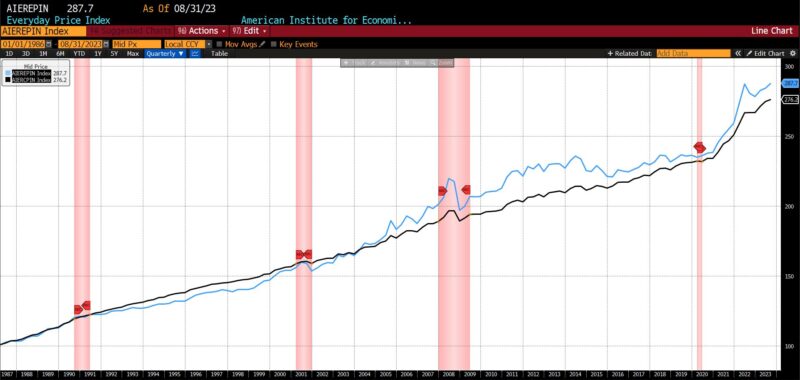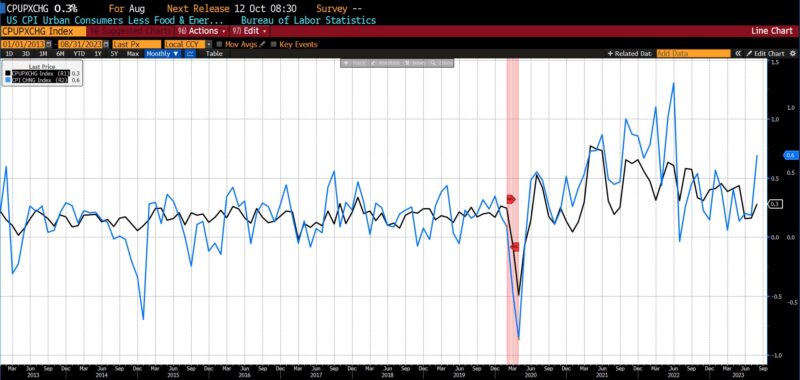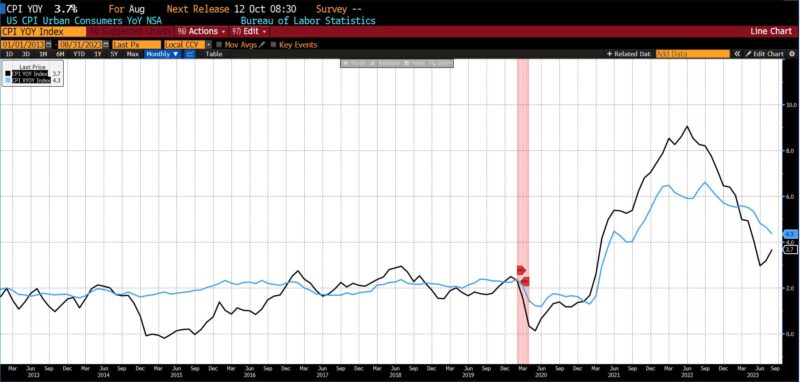
In August 2023 the AIER Everyday Price Index (EPI) rose 0.87 percent, lifting the index from 285.2 to 287.7. This was the largest monthly percent increase since January 2023 (0.93 percent). Additionally, 287.7 is the highest recorded index value, besting the previous EPI high of 287.1 registered in June 2022.
AIER Everyday Price Index vs. US Consumer Price Index (NSA, 1987 = 100)


(Source: Bloomberg Finance, LP)
Within the EPI, the largest monthly price increases were seen in motor fuel, housing fuel and utilities, and food away from home. Pet products, housekeeping supplies, and fees for lessons and instruction saw the largest declines in price, month-to-month.
On September 13 the Bureau of Labor Statistics (BLS) released Consumer Price Index (CPI) data for August 2023. The month-to-month headline CPI number rose 0.6 percent versus an 0.2 percent seen the previous month. The increase was in line with surveys, and was the largest increase in 14 months. Core (excluding food and energy) month-to-month CPI rose 0.3 percent versus an expected rise of 0.2 percent.
The largest contributor to the increase in the monthly headline CPI was gasoline, which accounted for over 50 percent of the increase. Shelter, which has now risen for 40 consecutive months, also played a role in the August acceleration of US prices. In the core index, the month-to-month rise was accounted for by rents, motor vehicle insurance, medical, and personal care. Prices for used cars and trucks and recreation declined the most in August.
August 2023 US CPI headline & core, month-over-month (2013 – present)


(Source: Bloomberg Finance, LP)
On a yearly (August 2022 through August 2023) basis, headline CPI rose 3.7 percent versus an expected 3.6 percent increase, compared with a 3.2 percent increase in July 2023. The increase in the year-over-year numbers is accounted for mostly in energy and food price increases. Year-to-year core CPI fell from 4.7 percent in July 2023 to 4.3 percent in August 2023. Again, shelter was a major (over 70 percent) contributor to the increases, as were motor vehicle insurance (up 19.1 percent), personal care (5.8 percent), and new vehicles (2.9 percent). The core CPI increase was in line with expectations.
August 2023 US CPI headline & core, year-over-year (2013 – present)


(Source: Bloomberg Finance, LP)
The core month-to-month CPI increase of 0.3 percent was the first increase since February, and comes at a time where likely Federal Reserve policy moves for the remainder of 2023 are being closely considered. From July 4th weekend until yesterday, the average US gasoline price per gallon has risen from $3.89 to $4.29, a 10.3 percent increase and the highest price since November 2022. But while the increase in gasoline prices was driven more by refining hindrances (owing to the summer heatwave and likely temporary), price increases in air travel, motor insurance, and several other categories were negative surprises. Grocery prices increased, but at the slowest pace (annualized) in over two years.
With the release of the data, market-implied policy rates ticked up in the three- to six-month range, indicating higher expectations of another 25 basis point Fed Funds increase toward the end of 2023. Despite some improvements since the apparent peak 13 months ago, consumers and businesses are still contending with 31 months of above-trend rising prices.




